|
HIGH SIERRA KARADON 65
TEST SERIES BY BRIAN HARTMAN
LONG-TERM REPORT
January 17, 2017
CLICK
HERE TO SKIP TO THE FIELD REPORT
CLICK
HERE TO SKIP TO THE LONG-TERM REPORT
TESTER INFORMATION
| NAME:
|
Brian Hartman
|
| EMAIL:
|
bhart1426ATyahooDOT com |
| AGE:
|
48
|
| LOCATION:
|
Central
Indiana |
| GENDER:
|
M
|
| HEIGHT:
|
5' 9" (1.75
m) |
| WEIGHT:
|
150 lb (68.00
kg) |
I have been backpacking for over
20 years throughout Indiana, Ohio, Kentucky and most recently in Western USA. In
addition to backpacking I enjoy family camping with my wife and kids and being
outdoors in general. I would describe myself as a mid weight backpacker. I use
fairly light weight equipment and gear but still like to bring more than the
bare essentials with me while on the trail.
INITIAL REPORT
PRODUCT INFORMATION &
SPECIFICATIONS
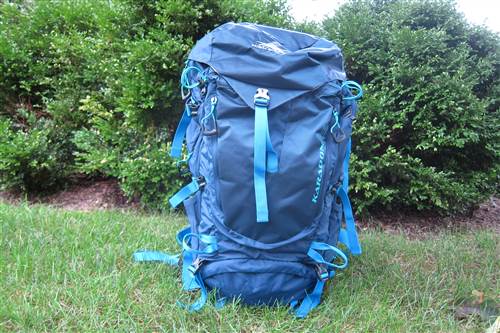 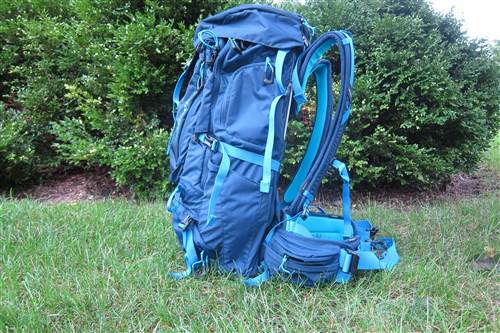 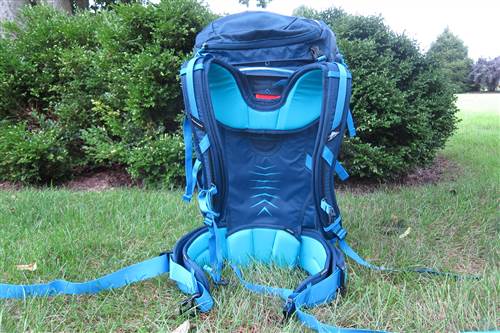
Manufacturer: High Sierra
Year
of Manufacture: 2016
Manufacturer's Website: http://www.highsierra.com/
MSRP:
$186.00 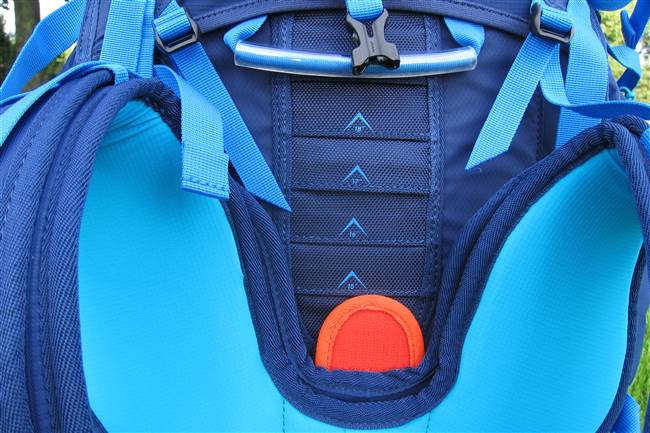 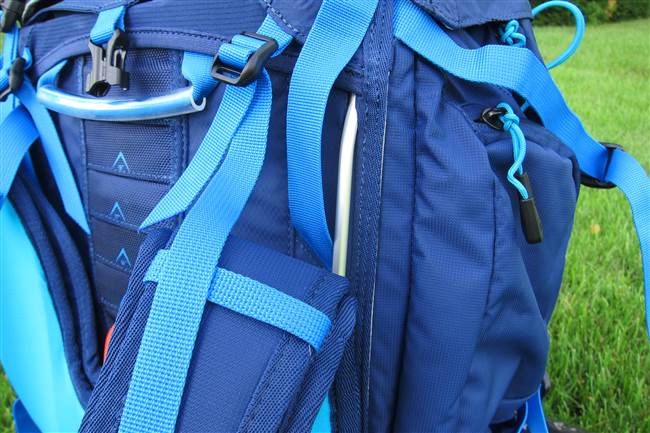
Listed Weight: 4.6 lbs (2.1 kg)
Measured
Weight: 4.7 lbs (2.1 kg)
Capacity: 3,950 cu in (65 L); as noted on hang
tag
Dimensions: 28.5 x 13 x 11.5 in (72 x 33 x 29 cm)
Material: 200D
Nylon, 70D Nylon, 1280D Polyester
Sizes Available: Small-Medium,
Medium-Large
Size Tested: Small-Medium
Colors Available: True Navy, Lime /
Kelly Green, Carmine
Color Tested: True Navy
Torso Length: Adjustable
Backpack Features:
Open side pockets
Open front pocket
Drawstring main compartment
Internal organization
Hydration
compatible: dedicated reservoir sleeve
Zippered accessory pocket
Padded
waist belt
Padded shoulder straps with sternum strap
Tuck-away webbing
grab handle
Reflective light blinker loop
Hidden helmet holder
Adaptable back panel system
Hidden rain cover
PRODUCT
DESCRIPTION
High Sierra's Karadon backpacks are brand new for 2016 and
range in size from 5 to 65 L (305 to 3,967 cu in). They are described as
technical backpacks and appear to be versatile and rugged for most types of
outdoor activities. High Sierra describes them as being built for stability,
comfort, and long-distance travel.
The Karadon 65 (hereafter called
Karadon, backpack or just pack) has a number of features as noted above; in
addition it has fully adjustable shoulder straps and hip belt, dual side-access
main compartment zippers and a removable lid. Finally, the shoulder, lumbar and
waist straps are removable so that they can easily be washed when dirty.
INITIAL IMPRESSIONS
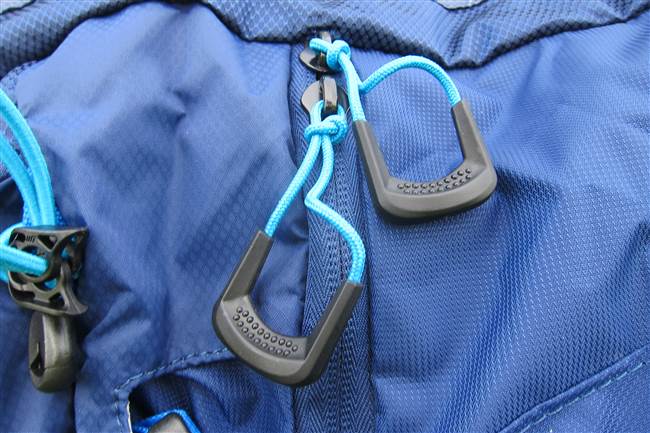 My initial impression of the Karadon 65 backpack was very positive.
At first glance the pack appeared well made with high quality workmanship
throughout: there were no loose seams, frayed fabric, or suspect areas that
would have caused me to be concerned. It also looked sharp with a navy and
bright blue color scheme and the manufacturer's name and logo on the top lid.
Although it's not the lightest weight pack at 4.7 lbs (2.1 kg), the Karadon 65
feels quite durable due to the types of materials used. Speaking of which, this
pack is constructed of 200D and 70D Nylon, with a 1280D Polyester bottom. It
also has an internal frame made of aluminum tubing to help stabilize the pack on
rough terrain and transfer load weight to the hips for support. The shoulder
straps, hip belt and lumbar area are fully padded to make long days on the trail
more comfortable, something I will evaluate during Field Testing. The many
zippers on this pack work well and they all have large pull cords which are some
of the nicest I've seen in a long time. The Karadon has plenty of straps for
doing everything from adjusting the shoulder harness and waist belt to cinching
awkward pack loads. All in all, this pack exudes quality and makes a great
first impression. My initial impression of the Karadon 65 backpack was very positive.
At first glance the pack appeared well made with high quality workmanship
throughout: there were no loose seams, frayed fabric, or suspect areas that
would have caused me to be concerned. It also looked sharp with a navy and
bright blue color scheme and the manufacturer's name and logo on the top lid.
Although it's not the lightest weight pack at 4.7 lbs (2.1 kg), the Karadon 65
feels quite durable due to the types of materials used. Speaking of which, this
pack is constructed of 200D and 70D Nylon, with a 1280D Polyester bottom. It
also has an internal frame made of aluminum tubing to help stabilize the pack on
rough terrain and transfer load weight to the hips for support. The shoulder
straps, hip belt and lumbar area are fully padded to make long days on the trail
more comfortable, something I will evaluate during Field Testing. The many
zippers on this pack work well and they all have large pull cords which are some
of the nicest I've seen in a long time. The Karadon has plenty of straps for
doing everything from adjusting the shoulder harness and waist belt to cinching
awkward pack loads. All in all, this pack exudes quality and makes a great
first impression.
Largest among the many pockets of the Karadon 65 is
its main compartment, which is accessible not only from the top but from both
sides and the bottom. Having accessibility to the main compartment from so many
directions is a wonderful thing in my opinion. I can't count the number of
times I've had to pull everything out of my pack in order to find an item or
piece of clothing I'd tucked in the main compartment a few days prior. A large
backpack with top access only to the main compartment can feel like reaching
into a black hole. Before I forget, the main compartment has (count them) two
draw cords, one exterior and one interior, for doubly securing any items inside.
I suspect the two draw cords are there to keep items firmly in place when the
top lid is not being used. Below the main compartment is a dedicated 'sleep
system' compartment with its own zippered entry from the front of the pack.
This compartment is ideal for a sleeping bag or top quilt. An internal divider
separates the main and bottom compartments, although it can easily be removed to
create one large compartment. Directly beneath the bottom compartment is a
pocket that houses the pack's rain cover. I love the fact that the rain cover
has its own pocket and that it is physically attached to the pack via a strap so
it can't be lost. And since this pocket is on the bottom of the pack, it
provides an additional barrier to water that might otherwise soak the bottom
compartment when the pack is sitting on wet ground.
Continuing on,
directly in front of the main compartment is a 12 x 9 in (30 x 23 cm) front
compartment, perfect for storing a rain jacket or other items that need to be
readily accessible. On both sides of the pack are zippered pockets measuring 6
x 4 in (15 x 10 cm) and below these are water bottle pockets that are the
perfect size for 32 oz (0.94 L) wide mouth Nalgene bottles. I like the fact
that these pockets are 8 in (20 cm) deep making it less likely for a water
bottle to fall out on the trail, something that happened to me before with a
pack that had shallow water bottle pockets. 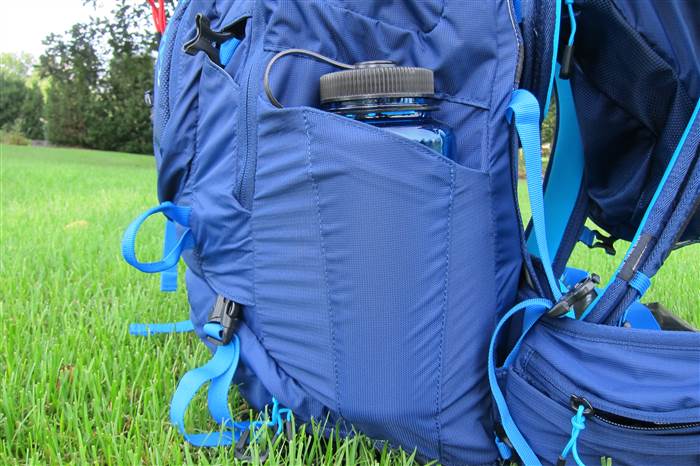
Two more zippered storage pockets are located in the
removable top lid. The first of these pockets is external and features a small
plastic clip for securing car keys. The second pocket is internal to the top
lid and is fairly flat, making it potentially good for map storage. And last
but not least are two 3 x 6 in (8 x 15 cm) pockets located on either side of the
waist belt. These are among my favorite pockets for storing small valuable
items as the pockets are easily accessible yet secure in the fact that they are
zippered. Unfortunately many packs do not have waist belt pockets so I'm happy
to see them on the Karadon.
Other features of the backpack include an
externally accessible hydration reservoir sleeve, side compression straps, a
sternum strap, and various loops and straps on the front of the pack for
securing trekking poles, a sleeping pad and various other items. Did I mention
there were lots of straps on this backpack?
The pack I'm testing, size
small-medium, is adjustable in torso length from 15 to 19 in (38 to 48 cm). The
procedure for doing so involves raising or lowering the shoulder strap assembly
and then securing it in place via a hook-and-loop tab integral to the shoulder
straps. The system is fool proof in that the tab can only be inserted into one
of five inverted pockets which are clearly marked and spaced one inch apart.
READING THE INSTRUCTIONS
The High Sierra Karadon 65 came
with three hang tags. Two of the tags stated quite simply 'detachable rain
cover' and 'removable / hand washable padding' respectively. The third hand tag
gave a brief introduction to High Sierra and Karadon backpacks, and then
proceeded to list some details regarding the pack. Finally it explained the
manufacturer's limited lifetime warranty.
Instructions for care and
cleaning of the pack were included on the third hang tag as well as on a cloth
tag located inside the pack and on the manufacturer's website. The instructions
were as follows: Clean with damp cloth as necessary. Do not use detergent or
bleach. Do not tumble dry. Do not iron. Remove wet items immediately.
TRYING IT OUT
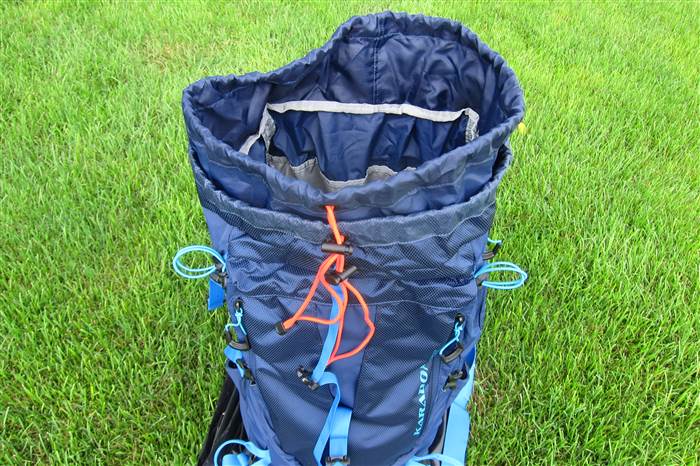 My first task before putting on the Karadon was adjusting the
shoulder strap assembly and waist belt to fit my torso. For reference my torso
length is 19 in (48 cm) and my waist size is 32 in (81 cm). I took measurements
per the instructions on High Sierra's website and then made the necessary
adjustments. The assembly was easy to slide up and down although the inverted
pockets that the tab needed to go into were understandably tight so the tab
wouldn't come back out on its own. My first task before putting on the Karadon was adjusting the
shoulder strap assembly and waist belt to fit my torso. For reference my torso
length is 19 in (48 cm) and my waist size is 32 in (81 cm). I took measurements
per the instructions on High Sierra's website and then made the necessary
adjustments. The assembly was easy to slide up and down although the inverted
pockets that the tab needed to go into were understandably tight so the tab
wouldn't come back out on its own.
After loading the Karadon with my
sleeping bag, tent, clothing and other gear I tensioned the side compression
straps and put on the pack. I found the waist belt to be supportive as it
minimized the weight on my shoulders. Next I adjusted the shoulder straps and
sternum strap to fit over my shoulders and across my chest. At this point,
although I felt like the backpack was properly adjusted, the part of it that
touched my shoulder blades and middle back was not particularly comfortable.
The shoulder assembly and backpanel is very hard with no contour at all, which I
think is the root of the issue. Having said that, I will continue to
investigate further and try some additional adjustments before coming to a final
conclusion.
SUMMARY
The High Sierra Karadon 65 is a
well-designed backpack with plenty of storage compartments and room for
essentials, however it wasn't very comfortable when I first tried it on. I am
hoping some simple adjustments remedy that situation and I look forward to
getting it on the trail for in-depth testing.
FIELD
REPORT
FIELD LOCATIONS AND CONDITIONS
%20resized.jpg) Since posting my Initial Report in September I took the
High Sierra Karadon 65 on three more backpacking trips for a total of six nights
and 38 mi (61 km) during this test period. Temperatures ranged from 40 to 74 F
(4 to 23 C) and the weather was generally nice with only one day of rain during
my outings. Elevations in the areas I hiked ranged from 530 to 790 ft (161 to
241 m). Since posting my Initial Report in September I took the
High Sierra Karadon 65 on three more backpacking trips for a total of six nights
and 38 mi (61 km) during this test period. Temperatures ranged from 40 to 74 F
(4 to 23 C) and the weather was generally nice with only one day of rain during
my outings. Elevations in the areas I hiked ranged from 530 to 790 ft (161 to
241 m).
My first trip of this test period was to the Hoosier National
Forest where temperatures were a comfortable 74 F (23 C). While there I hiked
approximately 15 mi (24km) across mostly hard packed trails with elevations
ranging from 560 to 710 ft (161 to 241 m).
Location: Southern Indiana
(IN)
Type of trip: Trail hiking
Distance: 15 mi (24 km)
Length of trip:
Two nights
Backpack weight: 36 lb (16 kg)
Conditions: Partly to mostly
cloudy
Precipitation: None
Temperature range: 58 to 74 F (14 to 23
C)
On my second trip I attempted to retrace my footsteps from a prior
hike, traveling approximately 12 mi (19 km) across farmlands and through two
small forests. My trek took me alongside a meandering creek which I crossed
several times before finally arriving at camp. My pack was heavier this time
around as I brought a 2/3 man tent in place of my hammock.
Location:
Southeast Indiana (IN)
Type of trip: Off-trail hiking
Distance: 12 mi (19
km)
Length of trip: Two nights
Backpack weight: 38 lb (17 kg)
Conditions: Mild and sunny
Precipitation: None
Temperature range: 40
to 71 F (4 to 22 C)
I hiked approximately 11 mi (19 km) on this trip. The
weather was cool and rainy on the first day but then cleared up allowing me to
enjoy sunny skies and moderate temperatures on days two and three.
Location: Southeast Indiana (IN)
Type of trip: Off-trail
hiking
Distance: 11 mi (18 km)
Length of trip: Two nights
Backpack
weight: 35 lb (15 kg)
Conditions: Rainy the first day but nice
afterwards
Precipitation: 0.4 in (1.0 cm)
Temperature range: 42 to 66 F (6
to 19 C)
PERFORMANCE IN THE FIELD
The Karadon 65 has performed very
well so far. It has lots of nice features, plenty of storage space, and a
rugged design. It's not the lightest pack nor the most comfortable but it's
well balanced, stays in place, and does a good job of handling heavy loads, all
of which are great qualities for a backpack.
The average weight of the
Karadon 65 with all of my supplies was 36 pounds (16 kg). The list of items I
carried included the following:
* Sleeping bag
* Tent with ground
cloth or hammock with rainfly
* Camp mattress
* Camp stove and fuel
canister
* Cooking pot
* Additional clothing
* Flashlight and
headlamp
* Food & water
* Essential backpacking articles
Fit
& Comfort: Although I was able to adjust the Karadon 65 so that it stayed
firmly on my back, the pack wasn't as comfortable to wear as I hoped. It would
help, at least for me, if the padding on the shoulder assembly was more
contoured and less rigid. As for the hip belt, it fit fine and was comfortable
with no pinching. It was easy to adjust the pack's fit via the shoulder straps,
load lifters, sternum strap, and waist belt. The internal aluminum frame also
did a good job of transferring the weight of the pack and supplies to my hips,
minimizing strain on my shoulders and back. For the most part I was able to
keep the pack tight to my back and grounded on my hips and this allowed it to
move with my body, making it easier for me to scramble up and down hills without
getting thrown off balance. Given the design of the pack, I think it could
easily handle another 10 lb (4.5 kg) of gear without breaking a
sweat.
The Karadon 65 was narrow enough that it did not impede my arm
movements and I didn't have any issues with the pack catching on tree limbs or
bushes while hiking through forests.
Storage space: The Karadon 65 was
easy to pack and the internal divider between the main and bottom compartments
allowed me to insert and remove my sleeping bag from the bottom compartment
without everything else falling into that space. The lid pockets came in handy
for storing snacks, maps, and sunglasses, and the front pocket was a great place
to store my rain jacket. Once the inside of the Karadon was packed I used the
side compression straps to cinch the pack so things wouldn't move
around.
I had no problems getting all of my gear into the Karadon, but it
was also easy to strap items to the outside of the pack. During my trip to
Southeast IN, my 2/3 man tent and reflective solar pad were two items that I
attached to the outside of the pack for convenience and the straps did a great
job of securing them. I also used the exterior side pockets of the pack to
carry my Nalgene bottles.
Durability: The Karadon held up well during
Field Testing. It is well-made, with durable nylon construction, and had no
problems on or off the trail. In fact, after two months of testing the fabric
shows minimal wear and no snagging. The padding on the shoulder straps and hip
belt are still in good shape and all of the seams on the pack remain tight with
no loose threads. Finally, the zippers and buckles continue to work
well.
Ventilation: The Karadon has enough ventilation and room for
airflow that my back hasn't sweated so far while backpacking. The reason there
seems to be plenty of airflow is because the padding on the shoulder harness and
waist belt hold the pack an inch or so (2.5 cm) off my back.
Weather
Resistance: One rainy weekend when I wasn't out camping I set the Karadon
outside for 15 minutes to see if it would shed water. It did an okay job for
the first 5 minutes but once the nylon fabric was saturated, water easily passed
through to the inside compartments. Thankfully High Sierra includes a rain
cover in the bottom compartment of the pack, and on my third trip of this test
period I had the opportunity to use it. What I determined after hiking in light
to moderate rain for over an hour was that the rain cover does a great job of
shedding rain and all of the items in my pack stayed dry.
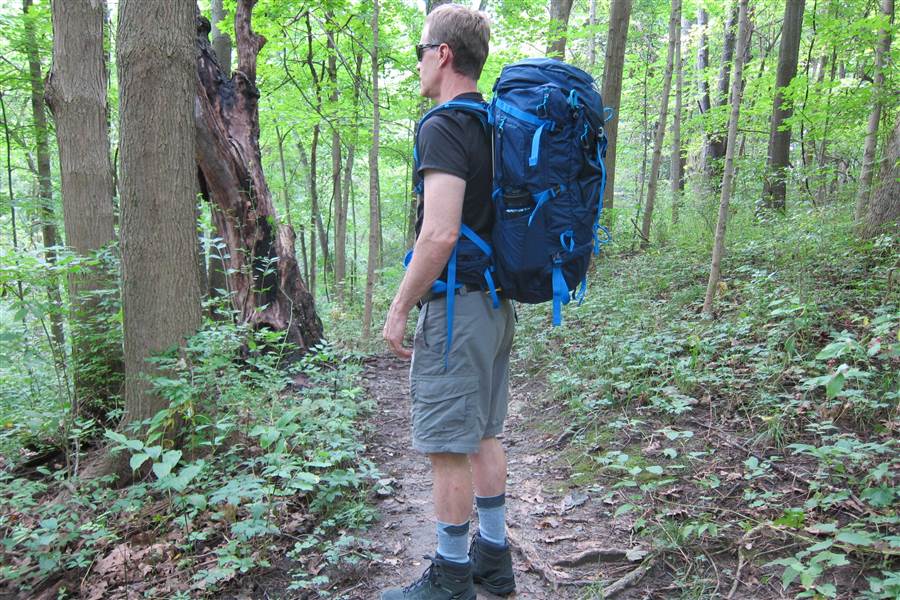 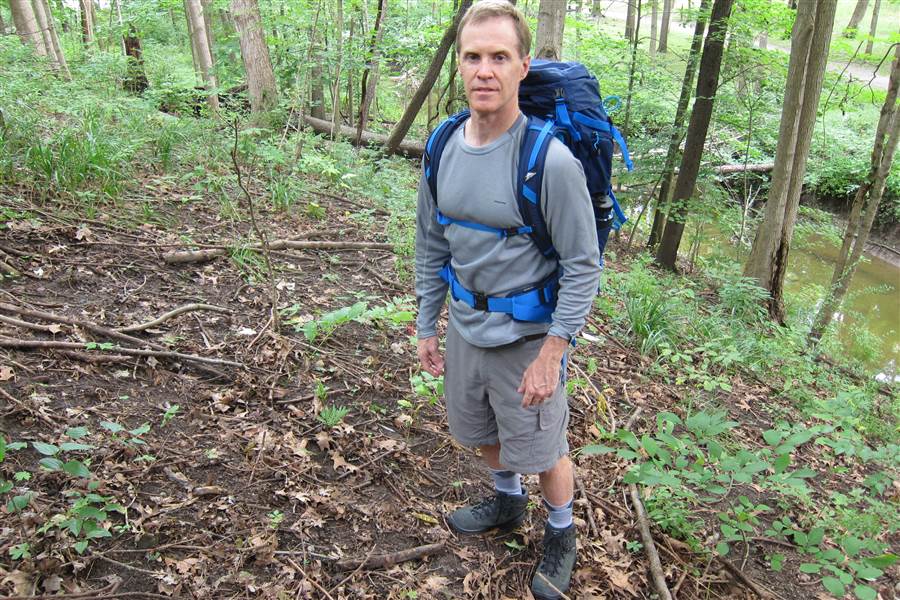
SUMMARY
The Karadon 65 performed very
well during the past two months of testing. The main storage compartment had
plenty of room and the pack was able to handle heavy loads and multi-day trips.
It was rugged, had ample storage space and plenty of room for my water bottles.
Although not overly comfortable, once I got the pack adjusted it stayed put on
my back and didn't move around as I scrambled up hills and over fallen trees.
LONG-TERM
REPORT
LONG-TERM TEST LOCATIONS AND
CONDITIONS
I took the Karadon 65 on two
backpacking trips during this test period, for a total of four days on the
trail. Both were weekend trips, one being to the Hoosier National Forest and
the other to Franklin County, Indiana (IN). Daytime temperatures were in the
teens (-10 C) on my first trip and in the lower 30s F (-0.5 C) during my second
outing, with mild to moderate winds both weekends. I hiked a total of 14 miles
(23 km) during long term testing and carried approximately 39 lb (18 kg) of pack
weight. The terrain was forested and quite hilly.
Trip 1:
Location:
Hoosier National Forest, Indiana (IN)
Type of trip: Trail hiking
Distance:
8.5 mi (14 km)
Length of trip: Two nights
Backpack weight: 39 lb (18
kg)
Conditions: Cloudy and cold with snow showers
Precipitation: 3 in (7.6
cm)
Daytime temperature: 14 F (- 10 C)
Trip 2:
Location: Southeast
Indiana (IN)
Type of trip: Off-trail hiking
Distance: 5.5 mi (9 km)
Length of trip: Two nights
Backpack weight: 39 lb (18 kg)
Conditions:
Clear and cold with gusty winds
Precipitation: None
Daytime temperature:
31 F (-0.5 C)
PERFORMANCE IN THE FIELD
In general, I was really pleased
with the performance of the Karadon 65. I found it to be well made and well
balanced with plenty of room inside for me to carry all of my gear.
During this test period I had no problems carrying almost 40 lbs (18 kg)
of gear. As the weather got colder and I switched from my hammock to a tent,
the Karadon made it very easy for me to secure the tent and my sleeping pad to
the outside of the pack. The waist belt and aluminum frame performed extremely
well in this regard, supporting the bulk of the weight as I hiked up and down
steep hills and along ridgelines. I felt no tender spots or pressure points on
my hips during or after hiking but, similar to my earlier experiences, the back
pads weren't very comfortable. Since I was wearing additional layers to stay
warm, the insulation in my jacket helped minimize any discomfort while hiking so
that the stiff back pad was more a minor annoyance than anything else.
Although I wasn't able to go on any extended trips with this pack due to
lack of time, I think I could have easily packed five days' worth of supplies in
the Karadon as it has plenty of space and is quite capable of carrying heavy
loads. The main storage compartment was a breeze to access from any direction
and I had no problems working the zipper pulls while wearing gloves.
The dual side pockets securely held my 1 Liter (33 oz) Nalgene water
bottles while the straps did a great job cinching my pack and also provided
plenty of options for attaching things externally. I found the other pockets
useful for stashing smaller items or items I needed quick access to, so that
they weren't in the main compartment with everything else.
Similar to my
Field Testing results, the Karadon 65 performed very well during Long Term
Testing in terms of durability. The pack endured tough conditions but the
fabric has no significant wear and the zippers, buckles and stitching remain in
great shape. The bottom and sides of the pack have a few mud stains and scuff
marks from trail use, but other than that the pack is in great shape.
My
only suggestions to the manufacturer would be to shorten the waist straps, which
were easily 2 ft (0.6 m) too long on each side, and make the pack belt so that
it can accommodate smaller waists. It would also be nice if one of the waist
pockets was a little bigger so I could keep my cell phone in it. These are all
minor things which goes to show how good this pack really is.
Pros
Rugged design with heavy duty fabric and zippers
Dual suspension system
helps carry heavy loads
There is plenty of space in the main compartment
The lower compartment works great for storing a sleeping bag
Zippered
waist belt pockets
Plenty of straps to cinch things down and to tie
additional things to the pack
Cons
Not the most comfortable pack for
me
SUMMARY
The Karadon 65 proved to be
rugged and well designed with plenty of easy-access storage and a really nice
integrated rain cover. It's not the lightest weight backpack in its class but
its innovative features and ability to handle heavy pack loads more than makes
up for the additional weight. Although it wasn't the most comfortable backpack
for me, I was able to wear it without any adverse effects (rubbing, pinching
etc) and will continue to take it on multi-day trips that require heavy pack
loads.
This concludes my report on the Karadon 65 backpack. Thanks to
High Sierra for providing this pack for testing, and to BackpackGearTest.org for
allowing me to participate in this test.
This report was created
with the BackpackGearTest.org
Report Writer Version 1. Copyright 2017. All rights reserved.
Read more reviews of High Sierra Sport Company gear
Read more gear reviews by Brian Hartman
|




